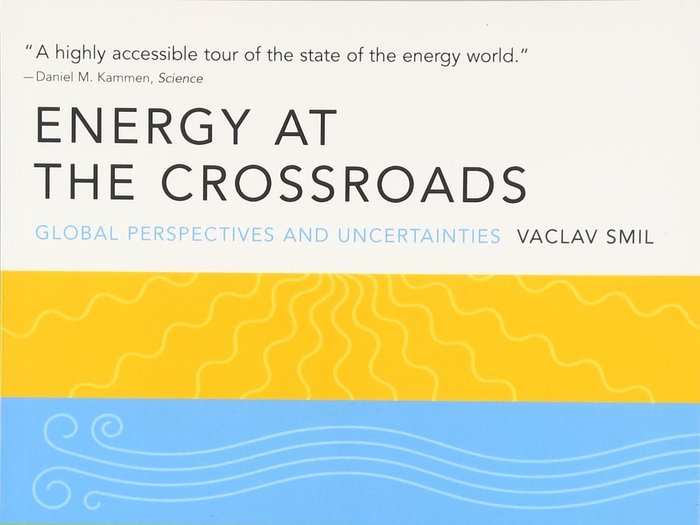
Gates recommended this book on energy by Smil in 2010.
"Energy at the Crossroads" discusses the history of energy, energy prices, the "real cost" of energy (i.e. the effect energy issues have on the economy, quality of life, the environment, and in wartime), and the pros and cons of fossil fuels.
Later in the book, Smil focuses on which clean energy solutions are most realistic and desirable.

Gates said Smil visited his office in 2010, and they had an enlightening conversation around possible solutions to some of the world's most pressing energy and environmental issues.
In "Global Catastrophes and Trends," Smil argues that global changes mainly happen in one of two ways: a single cataclysmic event or a persistent and slow movement in a different direction.
He takes a broad look at the catastrophes and trends — both man-made and natural — the next 50 years may bring.

Smil aims to evaluate clean energy promises from the media, politicians, business leaders, activists, and even scientists in "Energy Myths and Realities." Gates said the book's framework is useful in thinking about how to avoid our looming climate crisis.
"If you care about energy issues, I recommend this volume, though its unvarnished look at the realities of energy use and infrastructure may be disconcerting to anyone who thinks solving our energy problems will be easy," Gates wrote in 2014.

"Harvesting the Biosphere" made Gates' list of favorite books in 2013. It explores how human activity has changed the biosphere.
Smil examines different ways humankind has "harvested biomass" (e.g. hunting animals and growing crops), which has helped progress civilizations. At the same time, he argues that these activities are threatening the foundations of our well-being.
"Here he gives as clear and as numeric a picture as is possible of how humans have altered the biosphere," Gates wrote. "The book is a bit dry and I had to look up a number of terms that were unfamiliar to me, but it tells a critical story if you care about the impact we’re having on the planet."

Gates reviewed this book in 2014, noting "Not only did I learn some mind-blowing facts, but I also gained a new appreciation for all the materials that make modern life possible."
In "Making the Modern World," Smil considers the basic materials used throughout history, like wood stone, metals, alloys, plastics, and silicon. He then describes how each are produced, their main applications, and their environmental costs.
Smil also questions whether a gradual decline in the production of certain materials would lead to a decline in the global demand for them.

In 2015, Gates wrote that he enjoys how Smil never fails to question conventional wisdom in his work.
"Should We Eat Meat?" explores whether eating livestock — something humans have done for an estimated 2.5 million years — is healthy for us and the environment. Smil also covers ethical questions around raising animals for slaughter and details a few simple ways to eliminate cruelty.
The book is full of interesting statistics, Gates said. For example, a quarter of all ice-free land is used for grazing livestock. Every year, the average meat-eating American consumes more than enough blood to fill a soda can. And the US eats so much pepperoni each year that if all the slices were placed side-by-side, they would circle the Earth 50 times.

This nonfiction book explores how energy — from donkey-powered mills to renewable power sources — has shaped societies throughout history.
Smil makes the case that energy consumption and economic growth are undeniably linked.
"Yes, our history has a lot to do with kings and queens and games of thrones," Gates wrote. "Smil shows that it has even more to do with energy innovation."
Gates added that he disagrees with Smil on how quickly the world can completely transition to clean energy sources like solar and wind. Gates believes it will happen faster than Smil anticipates.
 Saudi Arabia wants China to help fund its struggling $500 billion Neom megaproject. Investors may not be too excited.
Saudi Arabia wants China to help fund its struggling $500 billion Neom megaproject. Investors may not be too excited. I spent $2,000 for 7 nights in a 179-square-foot room on one of the world's largest cruise ships. Take a look inside my cabin.
I spent $2,000 for 7 nights in a 179-square-foot room on one of the world's largest cruise ships. Take a look inside my cabin. One of the world's only 5-star airlines seems to be considering asking business-class passengers to bring their own cutlery
One of the world's only 5-star airlines seems to be considering asking business-class passengers to bring their own cutlery DRDO develops lightest bulletproof jacket for protection against highest threat level
DRDO develops lightest bulletproof jacket for protection against highest threat level
 Sensex, Nifty climb in early trade on firm global market trends
Sensex, Nifty climb in early trade on firm global market trends
 Nonprofit Business Models
Nonprofit Business Models

Copyright © 2024. Times Internet Limited. All rights reserved.For reprint rights. Times Syndication Service.